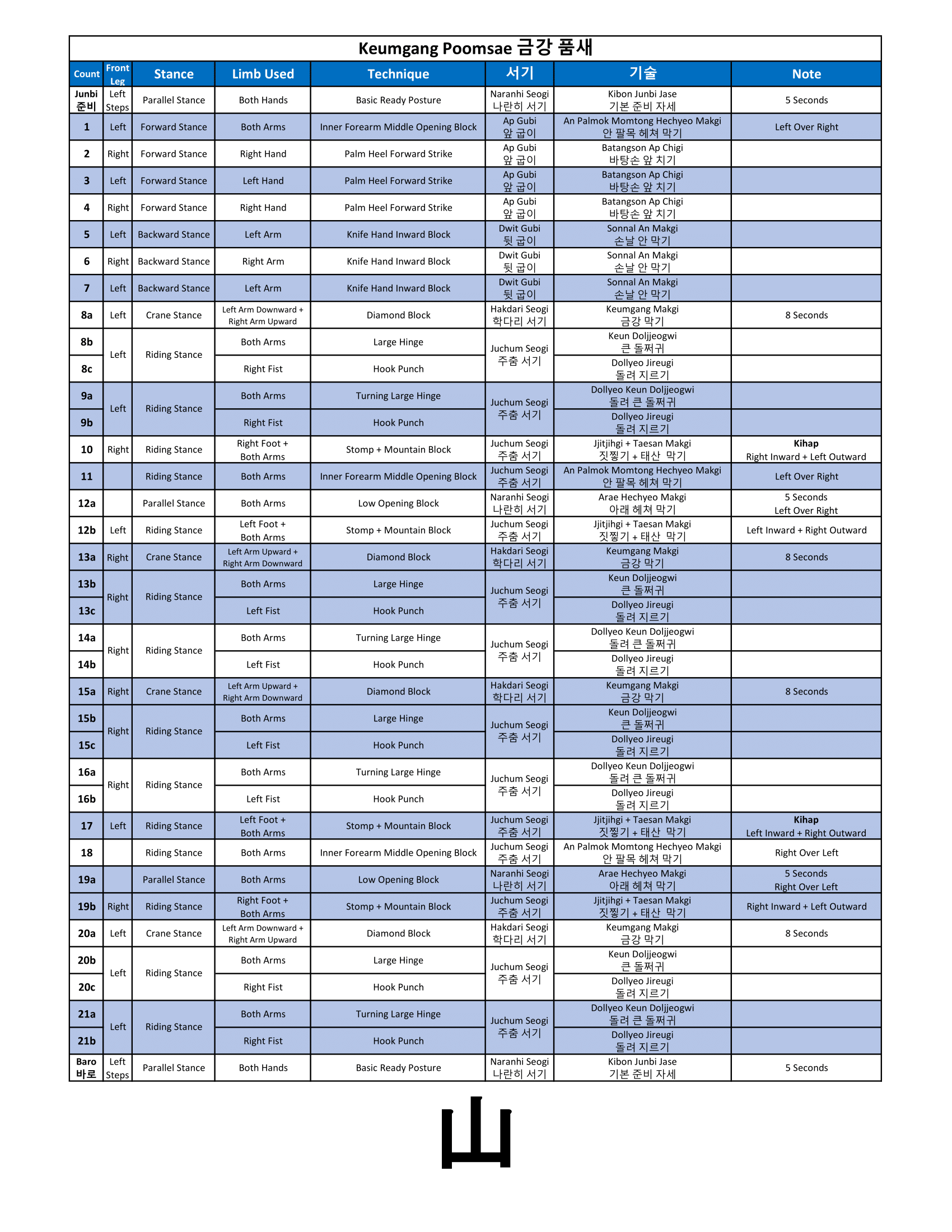Keumgang
금강
“Koom-Gahng”
Yeon-Mu Line: 山
Meaning: Indestructible
2nd Dan Poomsae
山
Keumgang (sometimes spelled Geumgang) refers to the ultimate strength and heaviness, which represents Mount Keumgang — the energy source of the Korean Peninsula and 호법 Hobeop which refers to the protection of the Buddha-dharma, with the two together constituting the guardians of Yin and Yang.
The name comes from 금강 역사 “Geumgang Yeoksa”, which signifies the strongest warrior who is a master of martial arts and symbolizes masculinity, strength and the indestructible. These factors are blended into the Keumgang Poomsae. Along with being the strongest, Keumgang means radiating light in all directions.
When applied to the human body, it refers to the body’s state full of energy and ready to exert power with any part of the body. This is possible by the coordination of the left and right and upper and lower body to move as one.
Further, it requires composure, no bias toward one side, and no recklessness, fear or hesitation. The Poomsae Line of Keumgang follows the 山 character. The vertical line in the middle represents the central axis of the body and spine while the short lines on the left and right signify the power created by twisting the body left or right from the center line.
When doing Keumgang Poomsae, the practitioner learns rotational moves based on the body center line (spine) to understand how to exert force with powerful moves while keeping the center firm like a big mountain.
“In Keumgang, you train the organic use of your body for ponderous and majestic expression. 금강 막기 Keumgang Makgi (Diamond Block) represents firmness and strength, as the word “Keumgang” suggests. Its Yeon-Mu Line 山 represents grandeur and stability. In practicing Keumgang Poomsae, you have to perform strong, stable but slow moves to develop strength and display the majestic Yudanja.
As all procedures of Keumgang Poomsae require maintaining balance at the same height while connecting the moves, the practitioner must have strong muscles in the lower body.
For example, 바탕손 앞 치기 Batangson Ap Chigi (Palm Heel Forward Strike) is not just a series of hasty moves; it should be ponderous but nimble. 학다리 서기 + 금강 막기 Hakdari Seogi + Keumgang Makgi (Crane Stance + Diamond Block) should be done slowly, straining the whole body, especially the 단전 danjeon (lower abdomen). Additionally, in 주춤 서기 Juchum Seogi (Riding Stance), you will practice shifting the weight and using the central axis of the body.”
Technique Summary
서기 Stances:
Closed Stance / Moa Seogi / 모아 서기
Parallel Stance / Naranhi Seogi / 나란히 서기
Forward Stance / Ap Gubi / 앞 굽이
Backward Stance / Dwit Gubi / 뒷 굽이
Crane Stance / Hakdari Seogi / 학다리 서기
Riding Stance / Juchum Seogi / 주춤 서기
방어 기술 Defensive Skills:
Inner Forearm Opening Block / An Palmok Hechyeo Makgi / 안 팔목 헤쳐 막기
Knife Hand Inward Block / Sonnal An Makgi / 손날 안 막기
Diamond Block / Keumgang Makgi / 금강 막기 (8 Seconds)
Mountain Block / Taesan Makgi / 태산 막기
aka Santeul Makgi / 산틀 막기Low Opening Block / Arae Hechyeo Makgi / 아래 헤쳐 막기 (5 Seconds)
공격 기술 Offensive Skills:
Palm Heel Forward Strike / Batangson Ap Chigi / 바탕손 앞 치기
Hook Punch / Dollyeo Jireugi / 돌려 지르기
Stomp / Jitjjihgi / 짓찧기
특수품 Special Skills:
Basic Ready Posture / Kibon Junbi Jase / 기본 준비 자세 (5 Seconds)
Large Hinge / Keun Doljjeogwi / 큰 돌쩌귀
Turning Large Hinge / Dollyeo Keun Doljjeogwi / 돌려 큰 돌쩌귀
기합 Kihap:
On the first Stomp + Mountain Block
On the third Stomp + Mountain Block
Performance Notes:
Rhythm / Tempo:
Be mindful of the different intervals between movements, which are determined by whether or not the next technique is offensive or defensive.Inner Forearm Opening Block:
The arms act in a double outward motion and NOT a double forward motion.Palm Heel Forward Strike:
The arm should be extended straight, just like a punch, with the fingertips 45° outward, as it is 3 attacking motions in a row the movements should be brisk.Knife Hand Inward Block:
Ensure that all 3 blocks have a 1st Position, even though some people perform it without. Just like a regular Inward Block make sure that the outer forearm ends up at the center line of the body.Backward Stance → Backward Stance:
Step directly from stance to stance and do not pre-pivot.Crane Stance:
The inner blade of the raised foot should be pressed against the inner knee with the foot relaxed. The raised thigh should be parallel to the floor.Diamond Block:
It should take 4 seconds for the Upward Block’s wrist to travel from the hip to the shoulder with the face turning to look in the direction of the Side Downward Block at 5 seconds. Each block should finish in its regular 2nd Position.Large Hinge → Hook Punch:
Your punch should be at solar plexus height with the forearm 1 fist’s width from the torso.Turning Step → Riding Stance:
Set the stepping foot 1 foot’s distance from the pivot foot.Stomp:
Lift the inner blade of the stomping foot to knee height with the sole of the foot facing up to the ceiling. Also follows the standard Step → Pivot order of operations.Mountain Block:
Lift the High Outward Side Block (the rear arm) parallel to the floor before beginning the outward motion. Always look toward the High Inward Side Block side — not to the middle!! Each arm makes a 90° angle with the wrist of each arm at eye height in 2nd Position.Inner Forearm Opening Block → Low Opening Block:
The dominant arm is determined by the foot that moved into the stance it is performed in.Beginning / Ending Position:
Keumgang will end slightly in front of its origin point on account of the first line of the poomsae as it features 4 Forward Stances moving forward followed by 3 Backward Stances moving backward in the beginning line.


